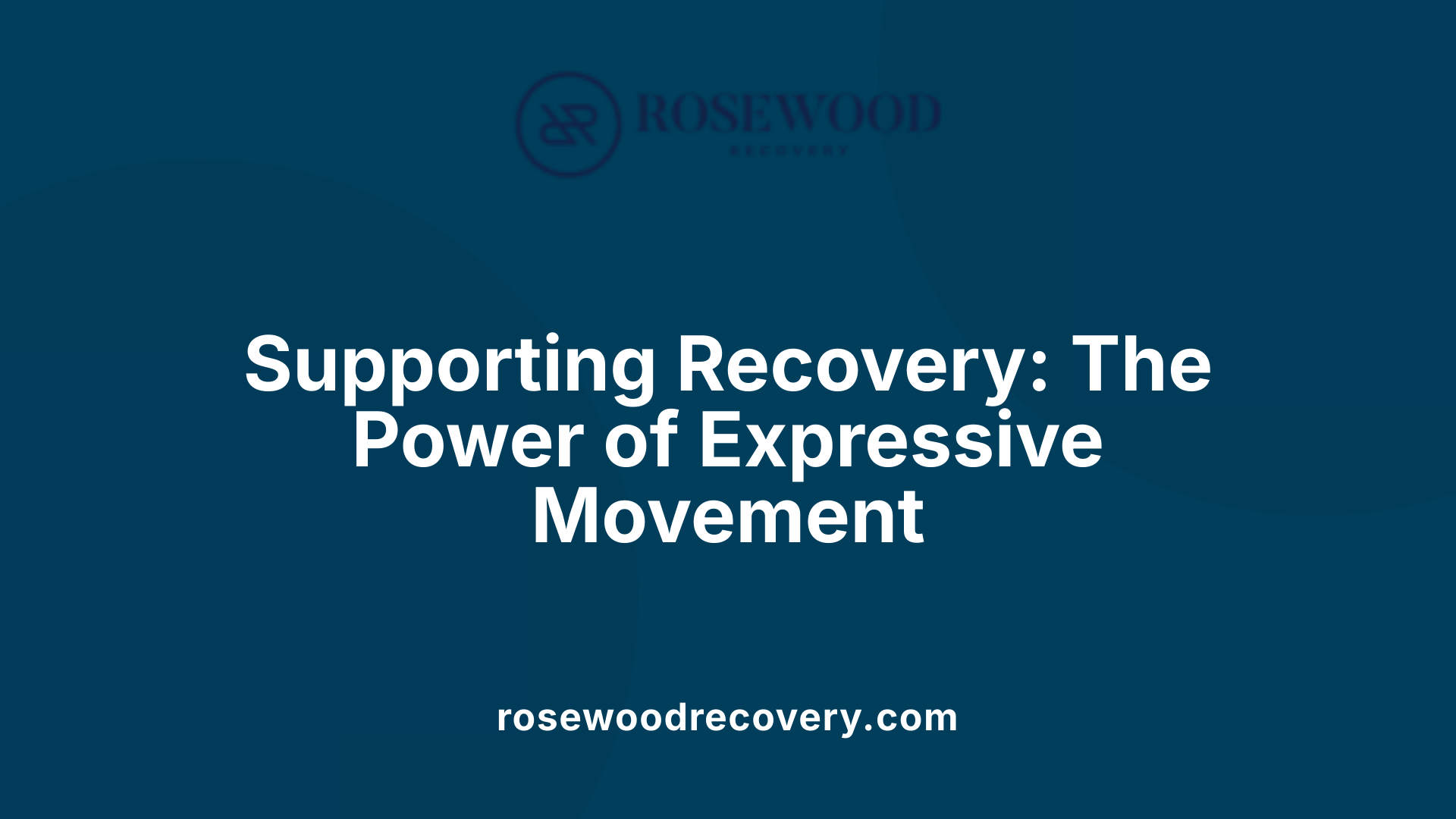Unlocking Emotional and Physical Resilience Through Movement Therapies
Recovery from addiction and mental health challenges is a complex journey that benefits greatly from holistic therapies. Expressive movement therapy, encompassing dance/movement therapy (DMT), and other arts-based approaches, offers unique advantages by enabling non-verbal emotional expression, fostering self-awareness, and supporting trauma healing. This article explores how these therapies facilitate emotional regulation, reduce stress, and contribute to personal growth during recovery, backed by scientific evidence and therapeutic principles.
Understanding the Foundations of Creative Arts and Expressive Therapies
 Creative arts therapies encompass a broad range of modalities including music, visual arts like painting and drawing, dance and movement, drama, and creative writing. Each form offers a unique channel through which individuals can explore, express, and process their emotions. Unlike traditional talk therapy, these approaches emphasize the process of creation over the final product, fostering self-discovery and healing.
Creative arts therapies encompass a broad range of modalities including music, visual arts like painting and drawing, dance and movement, drama, and creative writing. Each form offers a unique channel through which individuals can explore, express, and process their emotions. Unlike traditional talk therapy, these approaches emphasize the process of creation over the final product, fostering self-discovery and healing.
The central aim of these therapies is to facilitate emotional expression and personal growth. For example, art therapy allows individuals to externalize internal chaos through visual art, reducing feelings of shame and low self-esteem. Music therapy provides an outlet for regulating emotions and promoting relaxation, helping to manage anxiety and stress. Dance and movement therapy (DMT) encourages physical expression, improving body awareness and emotional regulation.
These therapeutic practices are especially beneficial for those recovering from trauma or dealing with mental health issues, including addiction. They help individuals confront difficult memories and feelings safely, often bypassing verbal barriers. Engaging in creative activities also induces a state called “flow,” characterized by deep focus and immersion, which enhances mental well-being.
Significant research supports the integration of expressive arts therapies into recovery programs. Evidence shows these therapies can decrease denial, improve mood, and bolster social skills. Studies dating back to the 1950s document reductions in trauma symptoms, anxiety, and depression through art and music interventions. They also help foster self-awareness, resilience, and ongoing coping skills, essential for sustained recovery.
Furthermore, expressive therapies support neurochemical changes such as the release of dopamine, associated with feelings of pleasure and satisfaction. They serve as alternative methods for emotional regulation, helping individuals replace destructive thoughts with healthier ones. Overall, these approaches provide a safe, non-verbal space for healing, making them valuable components of comprehensive recovery programs.
Effective Methods and Principles in Movement and Dance Therapy

What are effective methods and principles of movement and dance therapy in the recovery process?
In movement and dance therapy, several techniques are used to facilitate emotional expression, trust, and self-awareness without reliance on words. Effective methods include guided exercises such as mirroring, where individuals imitate the movements of the therapist or others to foster attunement and empathy. Improvisation allows for spontaneous movement, giving participants the freedom to explore emotions and experiences safely. Authentic movement involves free, mindful movement guided by inner impulses, helping individuals access deep-seated feelings.
These approaches enable clients to express emotions that might be difficult to articulate verbally, making them particularly useful in recovery settings dealing with trauma, addiction, or emotional distress. The core principles guiding these techniques emphasize the profound connection between body and mind. Movement therapists recognize that emotional trauma and unresolved issues can be physically stored, manifesting as tension, stiffness, or pain.
By engaging in purposeful movement, individuals can become aware of physical sensations linked to emotional states and process underlying trauma. This holistic process supports emotional regulation and integration, facilitating healing and resilience. Movement therapy is versatile and beneficial for diverse populations, including those experiencing depression, anxiety, trauma, and physical health issues.
Overall, these methods leverage the universal language of movement to foster self-exploration, emotional release, and physical well-being. They empower individuals to reconnect with their bodies, process complex feelings, and promote holistic recovery growth.
Support Systems and Outcomes of Expressive Movement in Recovery

How do expressive movement and creative arts therapies support addiction and mental health recovery?
Expressive movement and creative arts therapies play a significant role in supporting recovery from addiction and mental health challenges. These therapies offer alternative ways for individuals to express and process emotions that may be difficult or painful to verbalize. By engaging in activities such as dance, drawing, or music, individuals can externalize internal chaos, reducing feelings of shame and denial.
One of the primary benefits is the enhancement of emotional regulation. Participants learn to manage stress, cope with guilt, and build resilience. Group-based creative activities also promote social skills, foster community connections, and encourage shared healing experiences.
Neuroscientific research supports their effectiveness. Brain imaging studies show that arts-based therapies activate areas involved in reward, self-awareness, and neural plasticity. This activation helps reorganize disrupted neural pathways linked to addiction and trauma, supporting long-term recovery.
These therapies contribute to psychological healing by boosting self-esteem, fostering insight, and developing healthier coping mechanisms. As part of comprehensive treatment, creative arts therapies serve as a vital adjunct to traditional approaches, offering a safe space for exploration, discovery, and emotional growth.
Building emotional resilience, self-esteem, and social skills
Engaging in expressive movement helps individuals reconnect with their playful and carefree selves, which is crucial for emotional resilience. Creating art or movement routines allows participants to build confidence and a positive self-identity. These activities cultivate a sense of mastery and pride, especially when individuals successfully express complex emotions.
Social skills are strengthened through collaborative projects and group therapy sessions. Participants develop better communication, empathy, and trust, which are essential for maintaining sobriety and mental well-being.
The role of body awareness and physical health improvements
Body awareness is a core component of movement therapies like dance/movement therapy (DMT). Through guided exercises and improvisation, individuals become more attuned to physical sensations, emotions, and subconscious themes. Improved body awareness helps clients recognize emotional triggers and manage stress effectively.
Physical health benefits from regular movement include increased strength, flexibility, and cardiovascular health. These improvements support overall well-being, reduce anxiety, and contribute to a more balanced state of mind.
By integrating physical and emotional healing, expressive movement therapies provide a holistic approach to recovery. They help individuals regain control over their bodies and minds, fostering a sense of empowerment and resilience that sustains long-term health and sobriety.
Stress Reduction, Emotional Regulation, and Trauma Healing

How do expressive arts therapies aid in stress reduction and emotional regulation during recovery?
Expressive arts therapies are powerful tools that help individuals in recovery manage stress and regulate emotions effectively. They offer a creative, non-verbal way to express feelings, which is especially beneficial for those who find talking about their emotions challenging. Activities such as drawing, painting, dance, music, drama, and writing serve as outlets for emotional release, allowing individuals to process complex feelings in a safe environment.
These therapies promote relaxation and mindfulness by encouraging participants to focus on the present moment. Engaging in creative activities can lead to a decrease in stress hormones like cortisol, helping to calm the nervous system. The immersive nature of artistic expression fosters a mental state called “flow,” characterized by deep concentration and a sense of being fully present, which can reduce anxiety and depressive symptoms.
Beyond relaxation, expressive arts therapies enhance self-awareness and self-esteem. As individuals explore their emotions through art, movement, or sound, they develop greater insight into their internal experiences. This process helps normalize intense feelings, increases emotional resilience, and improves the capacity to control emotional responses.
Trauma resolution is a significant aspect of these therapies. By externalizing internal chaos—such as through painting or movement—patients can confront and process traumatic memories without being overwhelmed. This safe expression often leads to a reduction in distress and a sense of empowerment.
When combined with other evidence-based treatments, expressive arts therapies provide a comprehensive approach to mental health recovery. They address emotional triggers, support self-exploration, and foster coping skills necessary for long-term resilience. Overall, these therapies contribute to a reduction in psychological distress, helping individuals rebuild emotional stability and promote healing in their recovery journey.
The Role of Movement in Emotional and Physical Healing
How does expressive movement contribute to emotional and physical healing during recovery?
Expressive movement plays a vital role in healing by providing a nonverbal way to communicate feelings that are often difficult to put into words. In recovery settings, especially for individuals dealing with trauma or addiction, movement allows for the externalization of complex emotions such as anger, sadness, or shame without the need for verbal expression. This nonverbal communication helps process and integrate these feelings, promoting emotional regulation and trauma resolution.
Additionally, engaging in movement therapy enhances body awareness, enabling individuals to tune into physical sensations and recognize stress signals early. Techniques like dance and yoga foster relaxation, reduce tension, and lower anxiety levels, supporting overall physical health. Movement therapies also encourage mindfulness and self-compassion, which can decrease symptoms associated with depression and anxiety.
Studies show that expressive movement leads to the release of endorphins—natural mood lifters—while reducing the perception of pain and emotional distress. These activities serve as enjoyable distractions, offering relief from cravings, triggers, or negative thoughts. Moreover, participating in movement enhances self-esteem and resilience by fostering a sense of mastery and control over one’s body and emotions.
Through creative and spontaneous movements, individuals build internal strength, develop healthy coping skills, and reconnect with their physical selves. Such holistic approaches complement traditional treatments, emphasizing the mind-body connection crucial for comprehensive healing. In sum, expressive movement is a powerful tool in fostering emotional well-being, physical recovery, and personal resilience during the healing journey.
Transforming Recovery Through Creative Movement and Arts-Based Healing
Integrating expressive movement therapies into recovery programs offers a comprehensive approach to healing—addressing emotional, physical, and social dimensions. By fostering emotional expression, reducing stress, and promoting resilience, these therapies help individuals reconnect with their bodies and inner selves. Evidence underscores their effectiveness in trauma resolution, self-awareness, and long-term well-being. As part of holistic treatment, expressive arts therapies are powerful tools for fostering recovery, enabling individuals to find joy, purpose, and strength beyond their struggles, thereby transforming the recovery journey into a path of self-discovery and growth.
References
- The Benefits of Creative Arts Therapy in Recovery
- The Importance of Expressive Art Therapy in Recovery
- Exploring the Benefits of Dance and Movement Therapy in ...
- How Expressive Therapies Can Aid Addiction Recovery
- The Benefits of Expressive Arts Therapy in Recovery
- Mental Healing Through Expressive Therapies
- What Are the Benefits of Expressive Art as Therapy in Recovery?

.jpeg)


